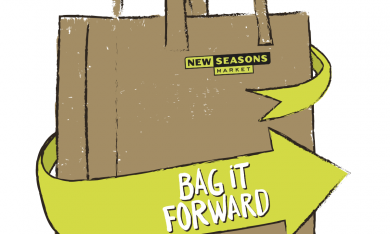
We are thrilled to have been selected as the Bag it Forward hunger partner with New Season’s March-August 2021. Thanks to all who voted for us! Your nickel makes a difference!

We are thrilled to have been selected as the Bag it Forward hunger partner with New Season’s March-August 2021. Thanks to all who voted for us! Your nickel makes a difference!
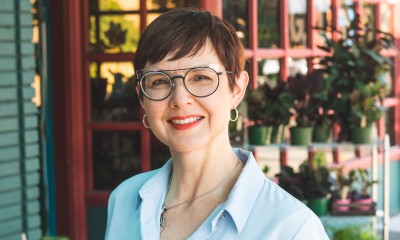
We are thrilled to announce the hiring of Sarah Iannarone to lead our organization, effective immediately.
An urban climate policy expert most notable for her candidacy for Portland mayor in 2020, Iannarone’s visionary leadership will help The Street Trust tackle unprecedented challenges facing transportation in the Portland region. Traffic fatalities are at a 24-year record high; the ongoing pandemic has gutted transit ridership and funding; and the current recession has also exacerbated disparities for BIPOC and low-income communities around jobs, housing, and transportation.
In hiring Sarah, all of us at the Street Trust are doubling down on our commitments not just to climate justice but our continued work to create safer streets where mobility, jobs and housing are accessible to all .
Portland’s new transportation commissioner, Jo Ann Hardesty, welcomed the announcement saying, “I believe in the power of advocacy to create a more just future. Sarah is the perfect person to lead The Street Trust and help bring Portlanders together for safer streets.” We couldn’t agree more.
There is much to be done in 2021 and beyond and we can’t wait to get to work with Sarah at the helm.
Welcome to The Street Trust, Sarah!
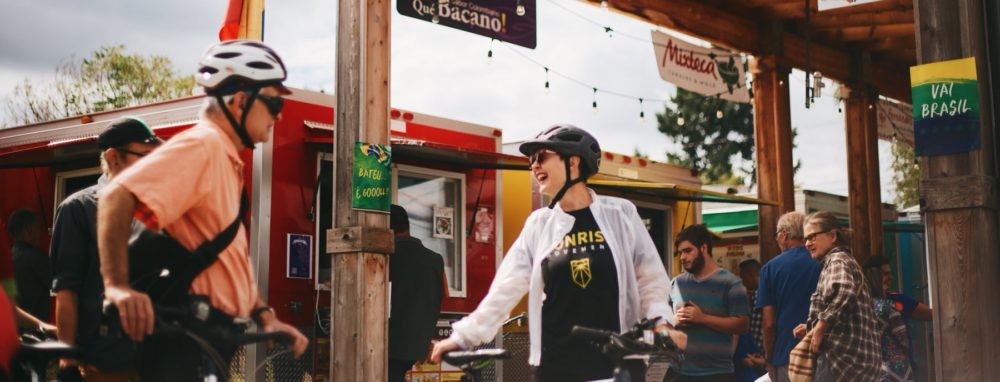

Our hearts break for George Floyd, his family, friends, and the Black community. We stand with Breonna Taylor and her community, and Ahmaud Arbery and his. Existing safely in public spaces as a Black person is a transportation issue and, more importantly, a human right.
Our heart goes out to the Black community who have, again, been denied the chance to fully heal from the wounds of anti-Black racism and the violence it elicits. We admire your resilience and will never stop fighting with you.
We are grieving, and we want to move together from grief to action. Please make a donation to these Black-led organizations on the ground in Minnesota and locally, and take action:
The Street Trust opposes the actions of City officials to limit peaceful protests against the killings of George Floyd and other Black bodies at the hands of the police. Streets are for people. If protestors want to use their public space to express their anger and demand change, then it is wrong for the police to demand they leave that space.
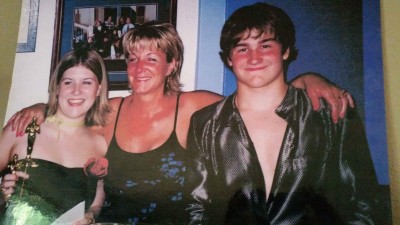
Eighty crosswalks and 45 light-rail stations made safer. That’s how Darla Sturdy sums up her proudest accomplishment to date. Sturdy, a Gresham mother and career bookkeeper, never imagined a second life as a transportation engineer, much less as a lobbyist. But this is the work she threw herself into after her boy was run over and killed by a MAX train.
Families for Safe Streets
On the evening of June 23, 2003, she got a knock on her door from a uniformed stranger asking if Darla was the mother of a boy named Aaron. “There were police there, and Aaron just didn’t get into trouble,” she recalled.
Darla told them yes she was Aaron’s mom and invited them in. One of them pulled out an ID card that showed a younger, hardly recognizable version Aaron, then a 16-year-old student at Gresham High. “It was completely out of date,” Darla remembers. But there was no question it was him.
That night, Darla’d been up waiting for Aaron to return from a church youth group meeting. But as she learned from her visitors — who also included a coroner and a chaplain trained in grief support — he’d been struck and killed in a crosswalk at the MAX station at Gresham City Hall, just five minutes from their house. Aaron was riding his bike westbound next to the MAX tracks and turned left to get across the tracks on the pedestrian crossing. He meant to cross behind an east-bound train that was just pulling out.
However, a second west-bound train was pulling in at about 35 mph and Aaron didn’t spot it until it was too late. The driver honked, but it was too late. Aaron’s bike left a 6-8-foot skid mark, according to the police report.
For months after her son’s death, Darla was in a daze. She lost weight and had to quit her job as general manager of the Spa Outlet. She says her mind just shut down. “I lost who I was. It’s kind of like when you lose a child, you lose you, too. And your family loses you, because you went with him.”
In her grief, she started taking daily drives from her home, to the MAX station, to the cemetery where Aaron buried — trying to make sense of it. At the MAX station, she watched trains coming in and out and saw several close calls with people crossing the tracks. A friend with a radar gun confirmed that incoming speeds were 35 mph. It settled in her mind that the crossings were unsafe — and that this is what killed Aaron. “It took me about three years, but I finally realized why God put me here.”
LOOKING OUT FOR EACH OTHER
Sturdy knew she could never bring back her own boy. But she could help other families avoid a similar fate. Having grown up in the small town of Milton-Freewater, Darla saw it as her duty. “In small towns, people look out for each other,” she said.
TriMet laid the MAX lines in Gresham in the eighties, when the Portland suburb was much less developed. Although a few newer MAX stations on Portland’s west side had gated pedestrian crossings, most didn’t, certainly not the legacy stations in Gresham, and by then Gresham had grown into a bustling suburb with schools, homes, and businesses right next to the tracks.
Sturdy began collecting data on MAX’s safety record, finding 505 crashes (including 108 with pedestrians or cyclists) between 1994 and 2006. She compiled photos of unsafe pedestrian crossings, including one in Gresham that lied just 25 feet from a public school. TriMet’s own internal guidelines called for protective gates for crossings within 600 feet of schools.
Darla took her growing folder of evidence to the Oregon State Capitol and began working there every Wednesday and Friday, meeting 12 to 15 legislators each visit to get support for a bill she dubbed Aaron’s Bridge to Safety. All the while, she pulled full shifts at the Spa Outlet on weekends.
It was no easy fight. After she’d collected the needed signatures in the House, the chairwoman of the transport committee refused to give the bill a hearing. “She was new, and she didn’t want to take on TriMet,” Darla explained. So she introduced the bill in the Senate, and “did it all over.
In 2007, the governor signed Senate Bill 829 into law, requiring TriMet to submit to an independent safety review of nearly 80 of its sidewalks. It took years of more lobbying– and the death of another pedestrian at the same Gresham City Hall crossing — but finally, the study’s recommendations were put into force. TriMet started carrying out the improvements in 2009, and they were at last finished in 2017 — 45 stations and 80 sidewalks made safer thanks to the tireless efforts of an angry mother.
TAKING IT NATIONAL
With that chapter closed, Darla has lately refocused her energy on family. But rail safety remains a huge concern, and Darla says she wants to take it national. In the meantime, she supports the local chapter of Families for Safe Streets and occasionally attends TriMet Board meetings along with another aggrieved parent, David Sale, whose daughter Danielle was hit and killed by a bus in 2010.
Looking back, Darla’s proud of her accomplishments but still struggles with the cost. “If I could go back in time, I’d want to have my son back,” Darla said. “Except for: I believe we have a purpose. God gave me this purpose, even with how hard it’s been.”
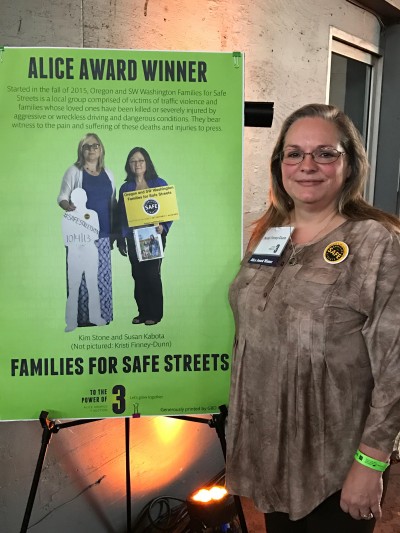
In recent years, Kristi Finney-Dunn has become a leading voice in Portland’s transportation scene. With a gripping story of personal tragedy, she’s invited to speak at public policy summits, street demonstrations and city council hearings. For local media, she’s become a go-to authority on active transport and road safety.
Others who’ve been impacted by traffic violence envy her resilience. But that’s just one side of the story. “When people see me talk, they’re seeing me at my strongest,” she assures. “They’re not seeing me at those moments when I’m curled up and burying my head and crying about it. Those moments don’t come all that frequently, but when they do come, they’re just as bad as the first few days.”
Kristi’s thinking back to the early morning hours of August 12, 2011, when her oldest son Dustin was struck and killed in a drunken hit-and-run in East Portland.
That night the 28-year-old was riding on SE Division near 85th Avenue when a car came up from behind, veered into the marked bike lane and struck not only Dustin but a second cyclist riding 60 feet ahead. The second rider walked away with minor injuries, but Dustin wasn’t so lucky. On impact, he flew 175 feet and died instantly of blunt-force head trauma.
The 18-year-old driver fled the scene but got less than a mile down the road before ditching his car, which sustained massive damage in the crash. Police picked him up a few blocks away and measured his blood-alcohol level at more than double the legal limit.
Kristi found out at 5 a.m., when a chaplain knocked on her door in Vancouver. After that, Kristi set about the grim task of telling Dustin’s three siblings, two still living at home or nearby and one who lived in Georgia. “I felt terrible for him,” Kristi says. “He’d just lost his older brother, and he was all by himself out there.”
THE FIGHT WAS ON
After the driver was convicted of negligent homicide and sentenced to five years of prison, Kristi finally began to grieve Dustin’s death and process what had happened to him. She devoured every article and blog post she could find about the crash. Dustin was a nature lover who loved cycling because it was good for the environment. But many who read about his death did not appreciate that. “What really got me were the comments,” Kristi said. “Oh, why was he riding at night? Why wasn’t he wearing a helmet? And I was thinking, ‘No, he didn’t die because he wasn’t wearing a helmet, he died because a drunk 18-year-old drove into the bike lane and hit him!’”
The fight was on. Kristi started up a blog about her experience, and made a couple dead-end efforts to fight hit-and-run driving. She discovered Trauma Nurses Talk Tough, a program at Legacy Emanuel Medical Center that educates people charged with DUI or high-risk driving about the impacts of traffic violence. In the program’s “victim-impact” sessions, people who’ve suffered losses in road crashes relate their personal stories to irresponsible drivers. Panelists include surviving family members like Kristi as well as those who’ve been physically maimed in traffic crashes.
Kristi, who has a day job in social services, speaks at a half dozen panel sessions per month. Her audiences run from 40 to 300 people, depending on which of six counties she speaks in. Every audience is a mixed bag. Every one includes a few hard cases who believe their driving is fine — they just had the bad luck to get a DUI. But there are also a few people who break down crying. These tragedies could have been on their heads. Some will come come up and give Kristi a teary embrace. “Sometimes, they won’t stop hugging you!” she says.
WORKING WITH A PERPETRATOR
In this work, the person who’s left the deepest impression on Kristi is a fellow panelist who had caused a crash. In that incident, which netted him eight years in prison, he ran into a family car and killed a mother and two children. The father survived with injuries.
Although Kristi has good reason to detest such a man, she says he’s touched her heart like no other speaker. The man describes how he still thinks about the surviving father and how he must miss his wife and kids every day. As Kristi says, “What I got from his saying that was that he’s truly trying to understand our feelings. It’s not just about him, that I did this thing, I made a mistake, I killed a couple people. It’s as if he’s really trying to understand that other person and how horrible it was.”
Along with the impact panels, Kristi represents traffic violence victims as part of the City of Portland’s Vision Zero Task Force. This is an advisory body guiding implementation of a new policy to eliminate traffic road deaths in Portland by 2025. The group meets formally four times per year.
And then there’s her work for Oregon and SW Washington Families for Safe Streets, which she convened in 2015 to both advocate and care for victims of traffic violence. The group is modeled on a pioneering organization in New York City and is now one of seven in North America.
As she found with the hit-and-run victims group, it is a struggle getting people to speak out about experiences that have caused such anguish. Nevertheless, when they do speak out, decision-makers tend to listen. An emergency speed limit reduction on SE Division, the street where Dustin and many others have died in traffic violence, came about in large part because of Families for Safe Streets’ no-holds-barred activism.
One motivator for Kristi’s advocacy is to keep the memory of Dustin alive. “Dustin was an advocate for causes that he cared about,” Kristi says. “Dustin wasn’t being quiet about his life and I’m not going to be either.”
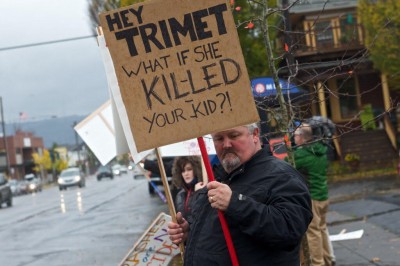
David Sale has been a builder his whole life, a carpenter who went from small jobs to steering his own multi-unit housing development. But the biggest project of his career has been one he didn’t choose: rebuilding his life after losing his second child, 22-year-old daughter, Danielle, in a bus crash.
The crash, which happened April 24, 2010, took the life of not only Danielle but that of another young woman, Jenee’ Hammel, and it left Danielle’s then boyfriend, Erik Gitting, with horrific injuries. Two others were struck but got away with relatively light injuries. The crash went down as the “worst tragedy in TriMet’s history” — in the words of the company’s own CEO.
The calamity unfolded just before midnight as driver Sandi Day was finishing her shift in Portland Old Town on a bustling Saturday night. A show had just let out at nearby Harvey’s Comedy Club, and Danielle and Erik were part of the crowd leaving the venue.
As the five waited to cross NW Broadway on Glisan, the bus was on the opposite side of Glisan letting off a passenger at an unmarked stop. The problem was that the route turns left on Broadway so Day should have been stopped in the left lane. A left turn from the curb was not only hazardous but illegal. But she did it anyway, sweeping across four lanes of traffic and into the intersection, where she plowed into the five unwitting pedestrians. According to Day’s court testimony, she wasn’t aware she’d hit anyone until she saw Danielle’s hair on her windshield.
Sale didn’t learn about Danielle’s death until the following morning. A preacher came to the door, and Sale could see the man’s car was parked across his driveway with the door wide open. Something was up.
Sale was home with his whole family — his wife and three other children. “I just lost it,” Sale said. “I pretty much collapsed on the front lawn.” As he recalls the memory, he stops and looks away for minute, regaining his voice. “It was a very rough day.”
Sale still wonders precisely when Danielle died. “Was it while she was stuck under the bus? Or while she was lying on the sidewalk, with a neck brace and a backboard and an IV stuck in her arm? That’s the last picture I have of my daughter.”
Later there was the visit to the hospital’s ICU, where Danielle’s boyfriend was being treated. “I was holding Erik’s hand and making decisions about organ donations and how people can benefit from my daughter’s death,” Sale remembers.
“She was so torn up, the mortician said if we wanted an open casket, we’d have to have the guests sign a release. So we just had a closed casket. I never saw her again.”
After Danielle’s death, Sale went on the warpath — determined not only to find justice, but to change the system so tragedies like Danielle’s wouldn’t happen again. He started with the justice system itself. Sandi Day had been convicted of several violations, including an illegal left turn and six counts of careless driving. But for all the devastation, she got away with an $1,100 fine and 200 hours of community service. Day automatically lost her commercial driver’s license in Washington State. But 10 days later, she got it back in Oregon. “Ten days!” Sale says, still amazed.
Enraged that Day was reinstated so quickly, Sale went straight to the top. Oregon Gov. John Kitzhaber was attending in Vancouver, WA, where the Sales live, and Sale went there to introduce himself. Sale told the governor he was the father of one of the TriMet bus victims and that he wanted a private meeting. Kitzhaber took Sale’s business card and handed it off to an assistant. Sale took out another card, stuffed it in Kitzhaber’s shirt pocket and said: “I’ll expect to hear from you SOON.”
Although Sale did get his meeting, the effort to stiffen Oregon’s licensing procedures came to nothing. Sale was not discouraged.
His family established a foundation, Dani’s Wish, to make anonymous donations to parents experiencing the sudden loss of a child. The donations aren’t huge, but they help defray funeral expenses of families who have plenty of other burdens. Sale raises money for the effort by running a non-profit mobile restaurant in a red, double-decker bus.
All the families filed a lawsuit against TriMet and the manufacturer of the bus that hit Danielle, and the two defendants ended up paying out $2 million each to the victims’ families.
One of the main arguments in the lawsuit was that the buses have a design flaw that obstructs drivers’ views. The left rear-view mirrors and “A pillars” — the posts on either side of the windshield that support the bus’s roof — form a 1.5 feet wide barrier that can compromise the safety of left turns.
To prove his point, Sale cited an experiment conducted on a public bus in Seattle where a camera was set up directly behind the driver to capture what they can see. At one point during the filming, the driver is making a left turn in a busy area, and as he steers into the cross street, a little kid darts outside the crosswalk into the driver’s field of vision. The bus screechs to a stop before striking the child — or the child’s family, who the driver hadn’t even noticed. “It’s like, ‘Oh! Didn’t see that,’” Sale says. “The only way he saw it, as you see in the video, was because the little kid got away from the rest of the group and ran in front of the bus.”
In the spring of 2013, Sale was invited to Philadelphia by the drivers’ union there (SEPTA) to help press home this very point to the city bus operator. The driver POV video of the unseen pedestrians made a big impact: The city changed the mirrors on more than 500 buses “just because I went to Philadelphia,” Sales says.
Publicity of the TriMet tragedy touched others in the transit industry. Among them were a Ohio-based company that delivers driver training programs, TAPTCO. They needed help with new course material, and Sale ended up putting together a half dozen “impact” videos to show bus drivers what can happen when complacency sets in. The training is used today by more than 450 public transit companies nationwide.
Sale continues to attend monthly TriMet Board meetings when he can to argue for better driver training, more strenuous pre-trip vehicle checks and better working conditions for drivers. Operator behavior is a major focal point of his advocacy. It was at a TriMet Board meeting that he met Darla Sturdy, whose son Aaron was struck and killed by a TriMet light-rail train in 2003. Sturdy and Sale are the only members of Families for Safe Streets who lost children in public transit crashes. Most members lost their loved ones in crashes involving private cars — including a fair few connected to drunk driving.
But the unexpected loss of a child is a common bond, and Sale likes to help other parents in their grief. Doing so helps in his own recovery. “It’s hard for people to step out of their comfort zone when something like that happens to your kid — or any family member, for that matter,” Sale says. “But with a kid, it might be a lot harder.”